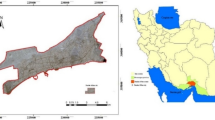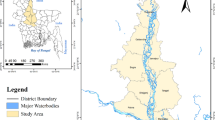Abstract
Urbanization is considered high priority in China. The present study focuses on a novel Geographical Information System-based approach to quantitatively assess the geo-environmental conditions for sustainable land-use development of an urban area. Fuzzy theories with analytic hierarchy processes are the most commonly used tools for land-use suitability evaluation. In fuzzy theories, a pattern recognition model is one of the tiny minority of models which can quantify the result. However, the key challenge is to provide each influencing factor with a quantitative value and selecting an approriate model to calculate the site’s adaptability for different infrastructures. The present study first proposes an approach coupling geostatistical analysis with three-dimensional visualizing technology to establish a reliable geological structural and high-precision informative geotechnical model to comprehensively understand the subsurface conditions of the research area. Then, an approach which uses an improved fuzzy pattern recognition method combining reliable geotechnical parameters to evaluate the geological environment is conducted. The weighting of each influencing factor in the final result is determined by an analytic hierarchy process. Finally, a zoning map of site adaptability is formed in the Geographical Information System for guiding land-use development. The study area is one of the most promising areas for urban and economic as well as airport developments in China, which is located on the northeast of Capital Beijing. This area may face several geo-environmental problems that will limit its suitability for infrastructure projects. The resultant models demonstrate the appropriate application of the presented methodologies. The quantified evaluation of the geo-environment could be combined with other conditions to provide decision-makers with improved reasonable land-use suitability scenarios.






Similar content being viewed by others
References
BIGPE (Beijing Institute of Geological and Prospecting Engineering) (2009) Three-dimensional geological investigation design report of engineered layers in Beijing plain
Chen S (1998) Engineering fuzzy set theory and application. National Defense Industry Press
Dai F, Liu Y, Wang S (1994) Urban geology: a case study of Tongchuan City, Shaanxi Province, China. Eng Geol 38(1–2):165–175
Dai F, Li J, Zhang X (2000) Application and evaluation of construction site and geo-environment in the urban area by using GIS. Earth Sci 25(2):209–214
Djokanovic S, Abolmasov B, Jevremovic D (2016) GIS application for landfill site selection: a case study in Pancevo, Serbia. Bull Eng Geol Environ 75(3):1273–1299
Dong M, Neukum C, Hu H, Azzam R (2015) Real 3D geotechnical modeling in engineering geology: a case study from the inner city of Aachen, Germany. Bull Eng Geol Environ 74(2):281–300
Fecht D, Beale L, Briggs D (2014) A GIS-based urban simulation model for environmental health analysis. Environ Model Softw 58:1–11
Goovaerts P (1997) Geostatistics for natural resources evaluation. Oxford University Press, Oxford
He ZX (1981) Fuzzy theory and its applications. Tianjin Technology Press, Tianjin (in Chinese)
Jain AK, Duin Robert PW, Mao JC (2000) Statistical pattern recognition: a review [J]. IEEE Trans Pattern Anal Mach Intell 22(1):4–37
Kanal L (1974) Pattern in pattern actions recognition: 1968-1974 [J]. IEEE Trans Inf Technol 20(6):697–722
Kazuki K, Akira O, Saito Y (2014) A GIS-based support tool for exploring land use policy considering future depopulation and urban vulnerability to natural disasters - a case study of Toyohashi City, Japan. Procedia Environ Sci 22:148–155
Krige D (1951) A statistical approach to some basic mine valuation problems on the Witwatersrand. J Chem Metall Min Soc S Afr 52(6):119–139
Kulawiak M, Lubniewski Z (2014) Safecity-a GIS-based tool profiled for supporting decision maling in urban development and infrastructure protection. Tech Forecast Soc Chang 89:174–187
Levy N, Benenson I (2015) GIS-based method for assessing city parking patterns. J Transp Geogr 46:220–231
Li Y, Yao L, Hu H (2010) Development and application of GIS-based multi-model system for risk assessment of geological hazards. Proc Int Conf Geoinformatics 2010:1–5
Lou S, Sun Z, Chen H (1983) Fuzzy Math. Science Press, Beijing
Mallet J (1989) Discrete smooth interpolation. ACM Trans Graph 8(2):121–144
Matheron G (1963) Principles of geostatistics. Econ Geol 58:1246–1266
Noor N, Asmawi M, Abdullah A (2015) Sustainable urban regeneration: GIS and hedonic pricing method in determining the value of green space in housing area. Procedia Soc Behav Sci 170:669–679
Ouyang J (1998) Introduction to fuzzy mathematics. Wuhan University Press, Wuhan
Qian Q (2012) Challenges faced by underground projects construction safety and countermeasures. Chin J Rock Mech Eng 31(10):1945–1956
Rikalovic A, Cosic I, Lazarevic D (2014) GIS based multi-criteria analysis for industrial site selection. Procedia Eng 69:1054–1063
Saaty TL (1977) A scaling method for priorities in hierarchical structures. J Math Psychol 15(3):234–281
Saaty TL (1980) The analytic hierarchy process, planning, priority setting, resource allocation. McGraw-Hill, New York, p 287
Saaty TL, Vargas LG (1991) Prediction, projection and forecasting. Kluwer Academic Publishers, Dordrecht
Sanchez-Lozano J, Teruel-Solano J, Soto-Elvira P, Garcia-Cascales S (2013) Geographical information systems (GIS) and multi-criteria decision making (MCDM) methods for the evaluation of solar farms locations: case study in south-eastern Spain. Renew Sust Energ Rev 24:544–556
Sinha N, Deb D, Pathak K (2016) Development of a mining landscape and assessment of its soil erosion potential using GIS. Eng Geol 216:1–12
Store R, Kangas J (2001) Integrating spatial multi-criteria evaluation and expert knowledge for GIS-based habitat suitability modeling. Landsc Urban Plan 55(2):79–93
Tudes S, Yigiter ND (2010) Preparation of land use planning model using GIS based on AHP: case study Adana-Turkey. Bull Eng Geol Environ 69(2):235–245
Tudes S, Ceryan S, Bulut F (2012) Geoenvironmental evaluation for planning: an example from Gumushane City, close to the north Anatolia fault zone, NE Turkey. Bull Eng Geol Environ 71:679–690
Uyan M (2013) GIS-based solar farms site selection using analytic hierarchy process (AHP) in Karapinar region, Konya/Turkey. Renew Sust Energ Rev 28:11–17
Wang P (1983) Fuzzy field and the application. Shanghai Science Press, Shanghai
Wang Z (1999) Applications of geostatistics in ecology. Science, Beijing
Xu H (2009) Environmental geology. Geology Publishing House, Beijing
Youssef A, Pradhan B, Tarabees E (2011) Integrated evaluation of urban development suitability based on remote sensing and GIS techniques: contribution from the analytic hierarchy process. Arab J Geosci 4:463–473
Acknowledgements
Financial support to the first author was provided through the Fundamental Research Funds for the Central Universities in China (2016QN4019). The authors would like to thank Beijing Institute of Geological and Prospecting Engineering for providing data resources.
Author information
Authors and Affiliations
Corresponding author
Rights and permissions
About this article
Cite this article
Dong, M., Hu, H., Xu, R. et al. A GIS-based quantitative geo-environmental evaluation for land-use development in an urban area: Shunyi New City, Beijing, China. Bull Eng Geol Environ 77, 1203–1215 (2018). https://doi.org/10.1007/s10064-017-1069-5
Received:
Accepted:
Published:
Issue Date:
DOI: https://doi.org/10.1007/s10064-017-1069-5




